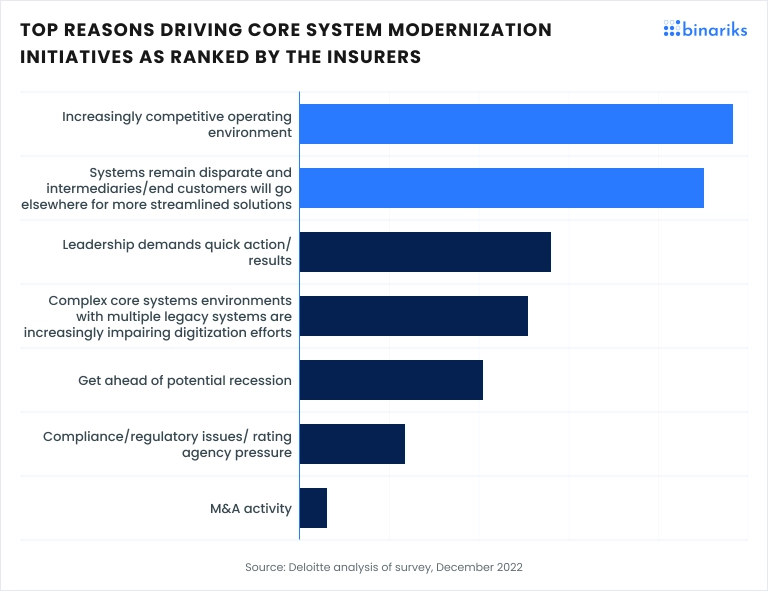How are outdated systems holding insurers back in the digital age? The insurance industry faces increasing pressure to modernize, and insurance legacy system transformation is the key to staying ahead.
Insurers relying on old, inflexible systems are often unable to integrate new technologies, meet evolving customer demands, or keep pace with market changes. Transforming these systems is crucial to boosting efficiency, reducing risks, and improving customer service.
By focusing on insurance legacy system modernization, companies can not only address current problems but also uncover new opportunities, empowering insurers to navigate the complexities of today's industry.
In this article, we'll consider:
- The core legacy systems in insurance;
- Challenges caused by outdated systems;
- Benefits of modernizing insurance legacy systems;
- Strategies and best practices for legacy system transformation.
Read on to discover how insurers can successfully transform their legacy systems for a digital future.
Core legacy systems in insurance and their challenges
Outdated systems in insurance are among major obstacles to growth and digital transformation. Here's a detailed breakdown of critical systems, their functions, current strengths, challenges, and how transforming insurance legacy systems can unlock new capabilities.

Insurance legacy system transformation is essential to eliminate inefficiencies and enhance digital integration. By upgrading these systems, insurers improve operational speed, data processing, and customer experience, positioning themselves for success in a competitive, tech-driven market.
What are the main problems created by insurance legacy systems?
Outdated insurance systems create numerous challenges for both businesses and customers. Below are the key problems associated with legacy systems, with examples illustrating how they impact daily operations and customer satisfaction.
Inflexibility in adapting to market changes
One of the most significant issues with legacy systems is their inability to adapt quickly to market demands.
For insurers, responding to new regulations, introducing innovative products, or adopting new technologies becomes a lengthy and costly process. These systems, built on outdated architectures, often require complex updates, even for minor changes.
For instance, when introducing products like cyber insurance to address modern risks, insurers may face significant delays due to the rigidity of their legacy systems. This is where insurance IT system transformation and leveraging insurance software development services become critical, enabling companies to quickly adapt to evolving market trends and stay competitive.

High operational and maintenance costs
Legacy systems are notoriously expensive to maintain. As they were built decades ago, many insurance companies find themselves constantly investing in costly patches and fixes just to keep these systems running. The outdated hardware and software used in these systems often demand specialized skills, driving up IT costs significantly.
For instance, a company running legacy billing systems may need a dedicated IT team to handle maintenance, making it difficult to allocate resources to innovative projects. This is why insurance legacy system migration is crucial—it allows insurers to shift to more cost-effective, scalable solutions, reducing ongoing operational expenses.
Poor customer experience
From a customer perspective, outdated systems lead to inefficiencies that cause dissatisfaction. Many legacy systems cannot offer the seamless digital experiences that customers have come to expect today. Slow policy approvals, delayed claims processing, and limited self-service options are common complaints.
For example, customers might have to wait days or weeks for claims to be processed due to legacy systems' inability to handle real-time data. Legacy insurance software migration helps resolve these issues, allowing insurers to modernize their systems and provide customers with faster, more efficient services.

How can insurers gain from legacy system transformation?
Upgrading legacy systems brings significant benefits to insurers, from cost savings to improved customer satisfaction. Below are five key advantages that come with legacy system modernization in insurance.
1. Increased operational efficiency
Modernizing legacy systems allows insurers to streamline operations, automate manual tasks, and reduce inefficiencies. Outdated systems often require manual intervention for processes that could be easily automated through modern technologies, freeing up valuable time for employees to focus on more strategic tasks.
Digital transformation in insurance systems can dramatically improve workflow speed and accuracy, allowing for faster policy issuance, claim processing, and customer service.
Allianz Direct became a top digital insurer in Europe by creating a cutting-edge platform that enhances self-service. With AI-driven loss assessment, customers can complete claims in 60 seconds by uploading photos and documents. This innovation boosted customer satisfaction by 90% and cut operational costs by 50% (Source ).
2. Improved data accessibility and decision-making
Legacy systems are often siloed, limiting an organization's access to comprehensive, real-time data. Through modernization, insurers can integrate different systems, enabling data to flow seamlessly across departments.
This leads to better decision-making based on real-time insights and more precise customer segmentation. Additionally, insurers can leverage insurtech trends to improve how data is used for risk assessment and pricing.
3. Enhanced customer experience
Customers today expect quick and efficient service, whether they file a claim or purchase a policy. Legacy system modernization enables insurers to deliver seamless digital experiences, such as self-service portals, faster claims processing, and personalized customer interactions. With modern systems in place, insurers can meet customer expectations and improve overall satisfaction.
AI implementation in the insurance industry has resulted in a 40% reduction in operational costs and a 25% boost in customer satisfaction.
Zurich Insurance, for example, leverages AI-driven predictive analytics to enhance fraud detection, allowing them to quickly identify suspicious activities and save billions annually. AI's ability to process vast amounts of data in real time significantly improves efficiency and reduces the risk of fraud, driving cost savings and customer trust (Source ).
4. Cost reduction and scalability
While the initial investment in system modernization can be significant, it leads to long-term cost savings. Modern systems are easier to maintain, require less manual intervention, and scale efficiently as the business grows.
For example, insurers can adapt their platforms to accommodate new product lines or expand into new markets without the extensive costs associated with upgrading a legacy infrastructure.
Fraudulent claims cost the insurance industry around $80 billion annually, but IoT technology is helping to mitigate these losses by providing real-time, accurate data to detect and prevent fraud. According to Virtusa, IoT devices also enable usage-based premiums, rewarding safe behavior and leading to cost savings.
Additionally, sensors facilitate proactive risk management by alerting insurers and policyholders to potential issues early, reducing major claims, and enhancing both safety and customer satisfaction (Source ).
5. Stronger security and regulatory compliance
Outdated systems are more vulnerable to security breaches and often struggle to keep up with regulatory changes. Modernized systems offer enhanced security features, protecting sensitive customer data and ensuring compliance with industry regulations. By investing in digital transformation, companies reduce the risk of data breaches and penalties associated with non-compliance.
The cyber insurance market is projected to reach $20 billion by 2025, underscoring the growing emphasis on cybersecurity. Notably, about 55% of US companies have purchased data-breach or cyber liability insurance, reflecting the increasing awareness of cyber risks, as highlighted by DataProt (Source ).
Legacy system modernization strategies for insurance companies
When evaluating how to transform legacy systems in insurance, a phased migration is one of the most effective strategies. This approach allows insurers to shift critical components of their legacy systems to modern platforms incrementally, reducing operational risk and downtime.
By testing and integrating new systems alongside existing ones, insurers can address potential issues early, ensuring a smooth transition without disrupting customer service or daily operations.
Cloud-based solutions are another key pillar of legacy system modernization strategies for insurance. Migrating legacy systems to the cloud provides insurers the scalability and flexibility needed to handle increasing data loads and support advanced technologies like AI, machine learning, and big data analytics.
Cloud adoption also enhances cost efficiency by reducing the need for costly on-premises infrastructure, making it easier to deploy updates and scale services as needed.
Finally, partnering with third-party experts can streamline the modernization process. External specialists bring industry-specific knowledge and technical expertise to help insurers navigate complex transformations. These partnerships ensure that the legacy system modernization is executed efficiently, mitigating risks and aligning new technologies with the insurer's business goals.
At Binariks , we recommend a hybrid approach that combines phased migration with cloud-based solutions as the most effective method for legacy system transformation.
This approach allows insurers to gradually modernize their systems without disrupting operations while benefiting from cloud technology's flexibility, scalability, and cost-efficiency. The phased transition minimizes risk, while cloud adoption enables the use of advanced technologies such as AI and real-time data processing.
Embrace InsurTech innovation with custom software development
How to implement such a transformation?
- Evaluate your current systems: Conduct a thorough assessment of your legacy infrastructure to determine which systems require immediate modernization. Focus on areas that most affect operational efficiency and customer experience.
- Create a phased migration plan: Start with non-critical systems and gradually migrate them to modern platforms. Test new systems alongside existing ones, allowing time to identify and resolve issues before fully transitioning crucial components.
- Adopt cloud-based solutions: The cloud offers flexibility, scalability, and improved security. Moving to cloud-based systems allows easier updates, better data integration, and more efficient resource allocation.
- Collaborate with experts: Engage external professionals with experience in system transformation to ensure the process is smooth, strategic, and aligned with your business goals. Their expertise can help navigate complex migrations and avoid common pitfalls.
While these are some basic steps, it's essential to acknowledge that every insurer's situation is unique. Factors such as the specific legacy systems in place, business objectives, competitive landscape, and operational challenges can vary widely. To craft a detailed, actionable plan tailored to your company's needs, consulting with experts is essential.
Out team offer deep expertise in legacy system modernization and can help you design and execute a strategy that ensures a smooth transition, keeping you competitive in a rapidly evolving industry.
Final thoughts
A well-planned, phased migration, combined with cloud adoption, can significantly improve operational efficiency, customer satisfaction, and cost management.
To ensure a smooth and effective transformation, partnering with experts is crucial. At Binariks, we specialize in helping insurance companies modernize their systems seamlessly. Our experience and tailored solutions can guide your business through a successful transformation.
Ready to transform your legacy systems? Contact Binariks today to discuss how we can help you modernize and future-proof your insurance operations.
Share

